With your MIG gun you have a variety of welding nozzle designs to choose from, and sometimes the decision on which to choose is not always clear.
The main function of your welding nozzle is to direct the shielding gas into the weld puddle in the most effective manner possible. The best welding nozzle choice will depend largely on your welding application, joint access, and process. Some welding nozzle designs offer better gas coverage; others offer better access. Some limit the efficiency of reamers in robotic applications.
The welding nozzle you choose should be heavily impact by your welding mode. Whether you weld in spray, pulse, or short circuit will heavily factor into the recommended nozzle design for your process.
So what are the pros and cons of welding nozzle designs? Let's go through the most common materials, designs, and features in detail:
Welding Nozzle Material
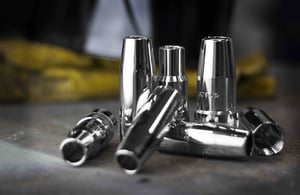 For the most part your MIG gun welding nozzles will be brass or copper in material. Brass welding nozzles have better spatter resistant properties in lower amperage applications than copper nozzles, but lose that advantage in higher amperage applications and can actually shatter when they fail. Copper welding nozzles have better overall spatter resistance and heat management at higher temperatures.
For the most part your MIG gun welding nozzles will be brass or copper in material. Brass welding nozzles have better spatter resistant properties in lower amperage applications than copper nozzles, but lose that advantage in higher amperage applications and can actually shatter when they fail. Copper welding nozzles have better overall spatter resistance and heat management at higher temperatures.
Nickel-plated welding nozzles (shown aside) have the advantage of increased durability and better spatter resistance than standard copper and brass nozzles. With nickel-plated welding nozzles you can always expect them to be plated to a copper nozzle, so you will benefit from all the good durability characteristics of copper with even great spatter resistance. The reason why nickel-plated welding nozzles last longer than regular copper is because the properties of nickel will deflect as opposed to absorb heat, meaning the inside and outside of your welding nozzle stay cooler while your MIG gun is operating. This allows for less spatter to stick to the nozzle, increasing it's life span. This is why plated welding nozzles are most common in robotic applications.
Threaded vs. Slip-on Welding Nozzles
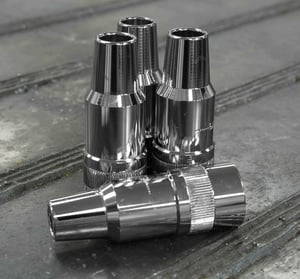 Usually there is little choice in the matter of picking on threaded or slip-on welding nozzle because your welding MIG gun will only accommodate one or the other.
Usually there is little choice in the matter of picking on threaded or slip-on welding nozzle because your welding MIG gun will only accommodate one or the other.
The difference between the two comes down to speed and the security of the connection. Threaded welding nozzles more securely connect to the welding torch which helps gas from leaking. Threaded nozzles also help with the concentricity of the contact tip because the threads won't allow the nozzle to be off-center.
The main downside to a threaded welding nozzle is they can be difficult to remove and replace if spatter bridges into the threads. Nozzles that feature a coarse thread design (as opposed to a fine thread) guard against this downside very well.
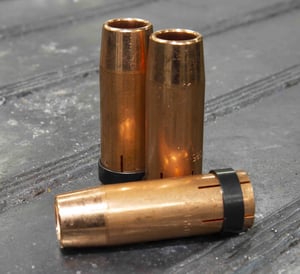 Slip-on welding nozzles are faster and easier to remove and replace. They are also better suited for overhead welding applications because those tend to produce much more spatter - especially at the base of the MIG gun's neck - and the easier to remove slip-on nozzle lends itself to protecting your other consumables like your diffuser during replacement. Slip-on nozzles are also typically lower priced than threaded, and that largely has to do with them being single-piece construction consumables as opposed to threaded which are normally two-piece construction and need more machining for the threads.
Slip-on welding nozzles are faster and easier to remove and replace. They are also better suited for overhead welding applications because those tend to produce much more spatter - especially at the base of the MIG gun's neck - and the easier to remove slip-on nozzle lends itself to protecting your other consumables like your diffuser during replacement. Slip-on nozzles are also typically lower priced than threaded, and that largely has to do with them being single-piece construction consumables as opposed to threaded which are normally two-piece construction and need more machining for the threads.
Usually a tension band of some sort is installed at the base of the welding nozzle or tip holder to keep it secured to the torch while welding. Sometimes these rings can loosen and cause the nozzle to displace. Slip-on nozzles also can sometimes cause your consumables to sit off-center if not seated back properly. For robotic welding applications, slip-on nozzles are typically not a recommended consumable because they are not very reamer friendly, as the nozzle can spin with the reamer blade while in a cleaning mode.
Conical Welding Nozzles
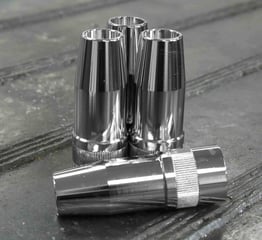 A conical shaped welding nozzle gives you the optimal gas coverage while still providing the sufficient visibility in manual welding. Due to the (inner) conical shape, the shielding gas covers a slightly wider area around the weld puddle than other nozzle shapes. The shape also accelerates gas into the weld puddle which helps to keep the weld from being influenced by turbulence or atmospheric conditions. Conical welding nozzles come in various bore sizes, the most common being ½” and 5/8” (13mm and 15.5mm).
A conical shaped welding nozzle gives you the optimal gas coverage while still providing the sufficient visibility in manual welding. Due to the (inner) conical shape, the shielding gas covers a slightly wider area around the weld puddle than other nozzle shapes. The shape also accelerates gas into the weld puddle which helps to keep the weld from being influenced by turbulence or atmospheric conditions. Conical welding nozzles come in various bore sizes, the most common being ½” and 5/8” (13mm and 15.5mm).
When welding zinc or zinc-coated metals, conical welding nozzles are the recommended nozzle shape to use. The reason being is because zinc produced very large and explosive spatter when being welded, and the clearance provided by the base of the conical welding nozzle allows for it to be reamed more effectively than other nozzle shapes assuming you use a two-stroke reaming process with air blast.
One drawback to conical shaped nozzle can be reduced accessibly around tooling compared to bottleform welding nozzles. Another can be reduced reamer-cleaning-efficiency when using a torch cleaning station in robotic welding. Since the inner wall of the nozzle is cone shaped and the reamer blade is straight, weld spatter can build up on the inner wall and reduce gas coverage. This can be addressed by proper anti-spatter application and a single-piece construction conical nozzle.
Another important consideration to make with your nozzle is your contact tip outer diameter against the inner diameter of your welding nozzle. If you're using, for instance, a 12mm inner diameter nozzle then you can safely use an 8mm outer diameter contact tip because you will get enough gas clearance to cover your weld appropriately. If you use a large size contact tip, like an M10 or M12, you will risk lowering your gas flow and risk porosity in your welds as a result as well as spatter bridging.
Bottleform Welding Nozzles
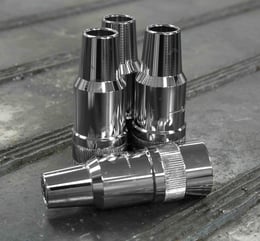 Bottleform style nozzles are nozzles that have the outer diameter that steps in to a reduced outer diameter on the work end of the nozzle – in the shape of a bottle. The Bottleform welding nozzles offer good workpiece accessibility and visibility of the weld. The bottle neck portion of the nozzle is usually a straight bore which allows for efficient and effective cleaning with a torch cleaning station in robotic applications. This is why bottleform nozzles are often used in robotic applications, despite being difficult to ream because of the small opening.
Bottleform style nozzles are nozzles that have the outer diameter that steps in to a reduced outer diameter on the work end of the nozzle – in the shape of a bottle. The Bottleform welding nozzles offer good workpiece accessibility and visibility of the weld. The bottle neck portion of the nozzle is usually a straight bore which allows for efficient and effective cleaning with a torch cleaning station in robotic applications. This is why bottleform nozzles are often used in robotic applications, despite being difficult to ream because of the small opening.
Compared to a conical nozzle, the gas coverage with a bottleform nozzle is tighter. This means, like with a cylindrical nozzle, that gas flow with bottleform welding nozzles can be more at risk for being impacted by atmospheric contamination.
When using bottleform nozzles there can be an increased risk of spatter bridging. As a general rule, the more constricted the front end of the welding nozzle is around the tip and tip holder the more at risk it of experiencing faster spatter buildup.
There are also Tapered Nozzles, which operate in a similar premise to the Bottleform Nozzle but with an even smaller bore size. These are made for extremely tight access for applications like pipe welding or very tight corners.
Cylindrical Welding Nozzles
 Cylindrical welding nozzles or sometimes referred to as straight nozzles, are very common when welding at higher amperages. They are a great option when welding with larger contact tips - such as heavy duty M10 or M12 size.
Cylindrical welding nozzles or sometimes referred to as straight nozzles, are very common when welding at higher amperages. They are a great option when welding with larger contact tips - such as heavy duty M10 or M12 size.
So if you're using an M10 contact tip, and welding at high parameters, you ideally want as much distance between the contact tip and the nozzle wall as possible because you want to both accommodate the contact tip and allow for as much gas to flow in as possible. Cylindrical welding nozzles also work great in high amperage applications because they can support large spikes in gas flow without causing porosity.
Because cylindrical welding nozzles have a larger straight bore, they offer the best nozzle reamer cleaning results around the tip and tip adaptor as well of the inner gas nozzle walls.
Cylindrical welding nozzles do have limitations in terms of access and also contact tip selection. Generally speaking, M6 and M8 style contact tips are not recommended with cylindrical nozzles. Using such a small contact tip with a nozzle that provides so much clearance can produce too much gas into the weld puddle and cause porosity as a result.
Welding Nozzle Sizes
Conical and Bottleform nozzles are available from 3/8” up to 7/8” (9.5mm up to 21.5mm). Cylindrical or straight welding nozzles are usually only available in larger bore sizes.
Whatever welding nozzle shape you decide on, use the largest bore size possible for your application without compromising accessibility to the weld joint.
This will optimize your gas coverage and reduce the possibility of quicker spatter build up that will affect gas coverage and cause porosity.
Welding Nozzle to Contact Tip Placement
With some manufacturers, the nozzle you use also determines tip placement. The welding nozzle you choose should have the correct tip placement for the welding mode of your application. MIG welding in short circuit, spray or pulse/modified pulse modes can heavily factor into the recommended nozzle design for your process.
Flush Welding Nozzles
With a flush welding contact tip you usually are MIG welding in short circuit mode. Because of this, you don't require as much of a wire stick-out, which allows you to better see where the wire is traveling as you weld. So with a flush nozzle, you do get better visibility on your part, which is beneficial especially for manual MIG welding.
One of the only drawbacks with a flush nozzle is that because the contact tip will sit inline with the bore of the welding nozzle, it can be prone to spatter bridging if not cleaned regularly or taken care of with some sort of anti-spatter solution.
Stick-out Nozzles
Stick-out nozzles are welding nozzles that allow for the contact tip to protrude out of the nozzle exit point to reach or even touch the workpiece before the nozzle. This type of welding nozzle is strictly to be used for issues of access from your torch to your weld piece.
Generally speaking, you would use a stick-out nozzle if you are MIG welding in a tight corner or deep down into a part you could not access otherwise. Gas coverage with stick-out nozzles are diminished because of the openness of the contact tip, so stick-out nozzles really only work as intended if welding in an area the gas can pool.
Recessed Nozzles
Recessed contact tips are intended to use with a longer wire stick-out. Typically when using a recessed welding nozzle you will be welding in spray or pulse mode - basically anytime you're welding at higher amperages.
The reason being is a recessed nozzle allows for the contact tip to sit deeper inside the nozzle and allow for greater gas coverage to the weld.
If you are MIG welding at high amperage, a recessed nozzle allows the gas to envelope the contact tip and flow to the weld piece. This gets the right amount of gas to the weld and combats against porosity.
Conclusion
With any welding nozzle no matter the material, shape, stick-out, or type, you can also prolong the life of the nozzle and combat against spatter by using anti-spatter products. Whether that be ceramic sprays, water-based solutions, or nozzle dips, there is likely an anti-spatter solution out there that will fit your process and budget and help you keep your nozzles from needing to be replaced sooner than they should be.

